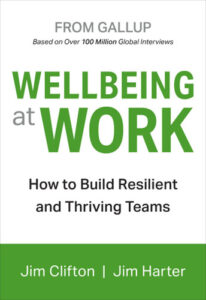 "Wellbeing at Work: How to Build Resilient and Thriving Teams" by Jim Clifton and Jim Harter is a thought-provoking and practical guide that emphasizes the vital role of employee well-being in organizational success. Published by Gallup Press, the book leverages decades of Gallup research to build a compelling case for prioritizing well-being as an essential leadership strategy. The authors make it clear that investing in well-being is not just beneficial for employees but also fundamental for driving performance, engagement, and long-term sustainability.
"Wellbeing at Work: How to Build Resilient and Thriving Teams" by Jim Clifton and Jim Harter is a thought-provoking and practical guide that emphasizes the vital role of employee well-being in organizational success. Published by Gallup Press, the book leverages decades of Gallup research to build a compelling case for prioritizing well-being as an essential leadership strategy. The authors make it clear that investing in well-being is not just beneficial for employees but also fundamental for driving performance, engagement, and long-term sustainability.
One of the book’s central themes is the introduction of five core elements of well-being: Career Well-Being, Social Well-Being, Financial Well-Being, Physical Well-Being, and Community Well-Being. According to Clifton and Harter, these elements are crucial for creating resilient and thriving teams. Career Well-Being focuses on finding meaning and purpose in daily work, while Social Well-Being emphasizes building strong and supportive relationships. Financial Well-Being is about managing finances effectively to reduce stress, and Physical Well-Being centers on maintaining good health and energy through positive habits. Lastly, Community Well-Being highlights the importance of feeling connected and contributing to one’s community. The authors argue that when these five elements are prioritized, employees not only perform better but also experience higher satisfaction and engagement.
A key message of the book is the pivotal role that leadership plays in fostering well-being. Clifton and Harter stress that leaders must go beyond traditional management and evolve into coaches who mentor and guide their teams toward building resilience and thriving both personally and professionally. Leaders are encouraged to model healthy behaviors, practice empathy, and actively support their teams in adopting well-being practices. By doing so, they create a workplace culture that values well-being as an integral part of daily operations rather than a mere add-on.
Another powerful aspect of the book is its focus on leveraging individual strengths through the Clifton Strengths assessment. The authors advocate for a strengths-based approach, where employees are encouraged to develop and use their unique strengths consistently. This approach fosters higher morale, motivation, and job satisfaction, while also aligning individual potential with organizational goals. By integrating strengths-based practices into well-being strategies, leaders can help their teams feel more confident and engaged.
The book goes beyond theory by offering practical strategies to implement well-being initiatives effectively. Some of the actionable recommendations include creating flexible work arrangements to alleviate stress, offering financial literacy programs to enhance financial security, fostering open communication and psychological safety, and building a culture of recognition and gratitude. Additionally, the authors highlight the importance of wellness programs that address both physical and mental health needs. These practical applications make the book a valuable resource not only for leaders but also for coaches and HR professionals seeking to build and sustain a well-being-centered culture.
Clifton and Harter’s message is clear: well-being is not a luxury or a trendy initiative but a fundamental component of sustainable leadership. By placing well-being at the heart of organizational strategy, leaders can build resilient, engaged, and high-performing teams. The book challenges outdated leadership models by emphasizing a human-centric approach that prioritizes people over processes.
"Wellbeing at Work" is more than just a guide; it is a call to action for leaders to rethink how they support their employees. Through data-driven insights, real-world examples, and practical advice, the authors make a strong case for making well-being a core organizational priority. Whether you’re a leader, a coach, or an HR professional, this book will inspire you to adopt new strategies that foster a thriving workplace. It’s a highly recommended read for anyone committed to sustainable leadership and team success.